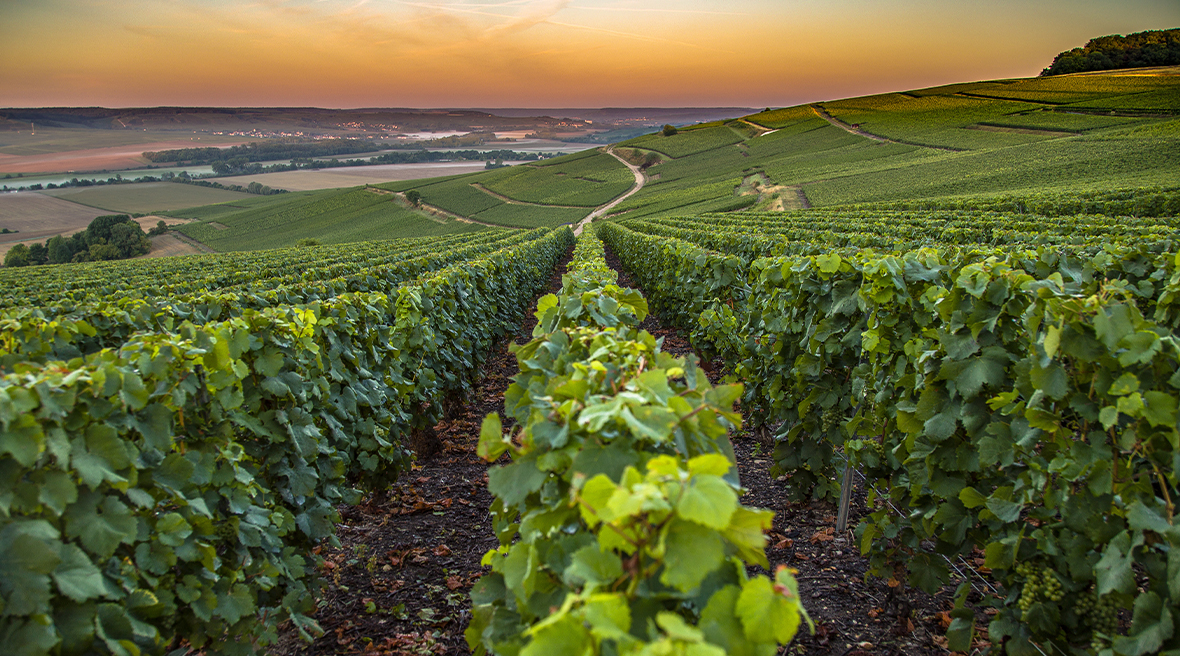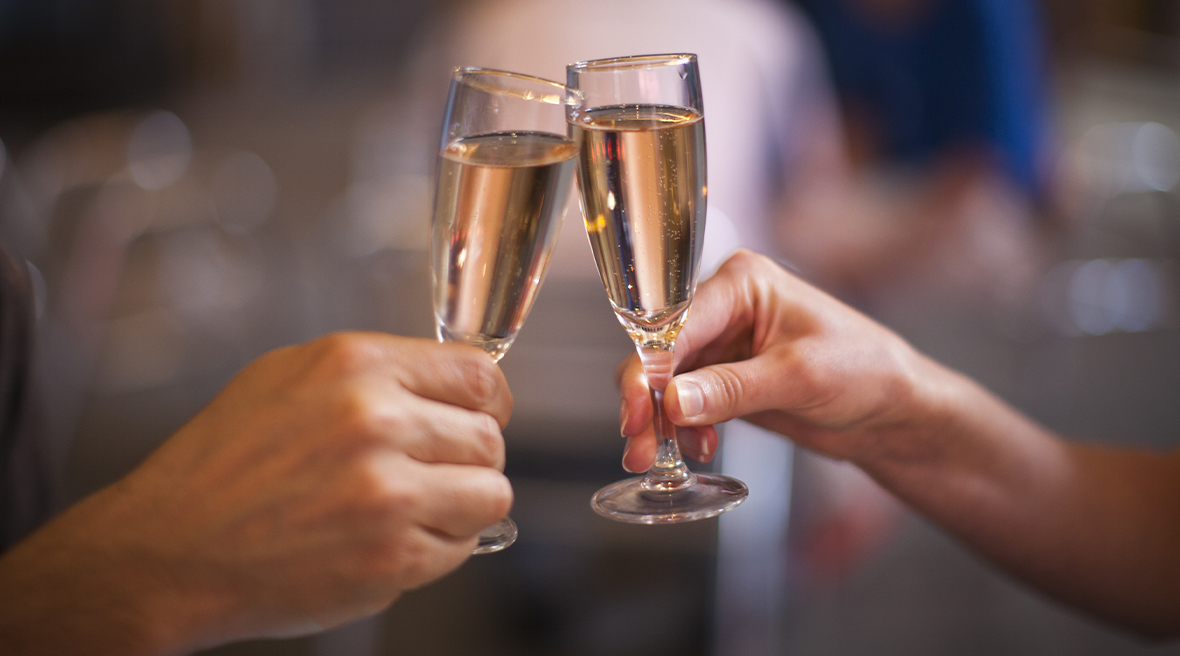How do I get to Reims?
To get to Reims, you can take a direct route from Calais, via the A26 and arrive in around two hours and 35 minutes. Of course, you may choose to take a longer, more scenic route instead to stop by some local sights along the way. We have a wonderful Driving to Reims guide for you to explore your options.
If you do decide to take the the most direct route from Calais to Reims, you will be driving on roads that include tolls. The A26 is a toll road and will cost you around €23.
What is Reims famous for?
Reims is possibly most famous for its champagne production. Here you will find some of the largest and most celebrated champagne houses, many of which are open for tours and tastings. However, it is also a great place to visit if you love to try new dishes. Reims can definitely be described as a ‘foodie town’ and even has its own signature dish.
Biscuits roses de Reims are a pink sweet treat that were first created by Fossier’s Confectioners in the 18th century. The recipe remains shrouded in mystery to this day, but they are traditionally covered in icing sugar and have a crunchy texture, meaning they’re perfect with a hot drink or some refreshing champagne.
Reims is also known for its beautiful Gothic architecture. We have highlighted some of the more standout attractions in this guide, but the entire city will delight the avid fan of historical buildings.
How many days do I need in Reims?
You can certainly see a lot of the highlights of Reims over a weekend, and we would certainly recommend using a bank holiday as your next opportunity to enjoy its sights. However, you could also choose to take a longer, more scenic journey to get to Reims to maximise your holiday, then take a few days to explore the beautiful city at your own pace.
What are the best things to see and do in Reims?
Reims is a Gothic architectural wonderland. The cathedral is perhaps its most impressive landmark, however there’s beautiful buildings around every corner. But this is also the perfect escape for lovers of the finer things in life, as Reims boasts four Michelin-starred restaurants and is the centre of champagne production. You can truly relax in this historical city and soak up some culture.
History & Culture
Although much damage was done to Reims during both WWI and WWII, the city has been meticulously restored to its previous glory. Dating back to 1211, the famous Reims Cathedral has seen coronations, conflict of war, and numerous restorations by celebrated architects and designers.
There are also Roman influences throughout Reims, with ruins to explore and more than one UNESCO World Heritage Site. Today, Reims is a popular destination for lovers of good food and drink, history, and architecture, drawing visitors of all ages from around the globe.
Reims Cathedral
 Reims Cathedral
Reims Cathedral
Reims Cathedral, also called the Cathedral of Notre-Dame at Reims, was the site of 25 coronations of the kings of France. This includes the crowning of Charles VII in 1429 with Joan of Arc herself in attendance. The cathedral took 80 years to initially construct, but thanks to damage and expansions, it has been in progress for centuries. With too many features to list here, the highlights include the L’Ange au Suorie (smiling angel) sculpture, stunning stained-glass windows in every colour of the rainbow, and the tour of the main tower which will take you up 250 steps.
Palace of Tau
A UNESCO World Heritage Site, the name of this palace is due to its T-shape structure. Unfortunately, most of the original building disappeared and had to be rebuilt, but the chapel dates back to 1207. As it was rebuilt between the 15th and 16th century, it has a distinct Gothic style. Like the cathedral, kings were coronated here and banquets held in their honour. Today you can visit it as a museum. Tour its sumptuously decorated rooms and look out for tapestries, statues and relics, including a gem-encrusted chalice from the 12th century.
Saint-Remi Basilica
 Stunning interiors at Saint Remi basilica
Stunning interiors at Saint Remi basilica
This was previously a Benedictine abbey, but now provides an opportunity to marvel at its combination of Gothic and Romanesque architectural features, including a triforium gallery and 12th century style chandelier. The unique light uses 96 candles, one for each year St Remi lived. The saint’s tomb can also be visited in the choir. A museum dedicated to the saint is right next door to the basilica.
Musée des Beaux-Arts
This museum dedicated to art is a treat for the eyes in itself, as it is an 18th century abbey. As well as over 20 works from Camille Corot and 2 Monet’ pieces, this is where you can see one of four versions of possibly one of the most famous paintings in the world, Kacques-Louis David’s The Death of Marat. After you have had your fill of the art, the museum is set within some wonderful gardens so you can take a stroll and discuss your favourite pieces.
Porte de Mars
 The impressive Porte de Mars
The impressive Porte de Mars
This enormous three-arched gate was built in the 2nd century AD in honour of the Emperor Augustus. You can walk around and under it to see highly-detailed carvings and markings, including Roman Gods and Goddesses Jupiter, Leda, Romulus, and Remus. Named for a nearby temple to Mars God of War, it once served the city of Reims as a gateway until 1544.
Fort de la Pompelle
This is for the lovers of World War history, as this fort is one of a few that were built around the city in and after 1870 for protection. Fort de la Pompelle was the only fort to remain in the hands of the allied forces during WWI and protected city of Reims. It saw the heaviest fighting of the Reims forts, being bombarded numerous times including during the Second Battle of the Marne in 1918. Now a fascinating museum, it reveals unique items like headgear worn by the German imperial army and military uniform collections.
Place Royale
Reims Royal Square has been a focal point of the city since Jean-Gabriel Legendre planned its design in 1760. With architectural features like balustraded roofs and arcades, there is also the impressive statue of King Louis XV at its centre. The statue is not the original however, as this was melted down to make cannons during the French Revolution.
Bibliothèque Carnegie
If you’re in need of a little peace and quiet, head to the Bibliothèque. This art deco building is a public library, donated to the city by businessman Andrew Carnegie after WWI, hence its name. Its 1920s design makes it stand out against all the other Gothic buildings, and you should definitely head inside to see more. The reading room has two glorious stained-glass windows that feature a design of books and there are little gems of 20s design dotted about the entire building, including a hanging lantern by Jacques Simon in the main hall.
Chapelle Foujita
Another unusual piece of architecture, Japanese painter Léonard Foujita both designed and decorated the Lady of Peace Chapel in the refined Japanese tradition. He said he completed the work to “atone for 80 years of sin” and converted to Catholicism after studying at the School of Paris in 1913. He was baptised at Reims Cathedral.
Intricate frescos cover every wall under the beamed roof and even the stained-glass windows were included as part of Foujita’s design, despite being made by master-glassworker Charles Marq.

A beautiful view across the Champagne region
Champagne houses in Reims
You cannot be blamed if your first draw to Reims was the champagne, rather than the opportunity for sightseeing. Below are some of the champagne houses you can visit in the area, with the opportunity to take a tour, learn more about the delicious drink and, of course, taste a glass or two.
Caves Vranken-Pommery
The Vranken-Pommery Champagne House is a unique one. Take a tour into its chalk caves and as well as bottles of bubbles, you’ll see modern art installations including light and sound exhibitions. Learn about the Vranken and Pommery families and the different styles of champagne they created.
The Villa Demoiselle is a treasure trove of art nouveau and art deco style. Bought by the Vranken family in 2004 and fully restored, you can wander through its rooms and champagne cellars, plus enjoy a glass in the gardens after your tour.
Maison de Champagne Taittinger
Tours of this house will take you back in time on a tour of the remnants of the old Saint Nicaise Abbey, dating back to the 13th century, then down to a depth of 18 metres to the Gallo-Roman chalk vaults carved out of the hillsides and listed as a UNESCO World Heritage site. With 288 hectares of vineyards at its disposal, Taittinger also uses the most environmentally friendly techniques to make its champagne.

Maison de Champagne Lanson
The House of Lanson was founded in 1760 by François Delamotte, a prominent member of Reims society. When his son, Nicolas-Louis Delamotte, took over in 1798 he decided to use the Maltese Cross as the House’s emblem, having been admitted as a knight of the Order of Malta.
Lanson Champagne House boasts that it is “the only Grande Maison in Reims to offer a champagne experience from the vine to the flute.” The tour is a detailed look at the old and new riddling processes, starting in a small vineyard on site and down to the cellars.
Champagne Veuve Clicquot Ponsardin
Veuve Clicquot is known for its classic and distinctive yellow-labelled design. Founded in 1772 by Philippe Clicquot it’s one of the largest champagne houses in the world. Philippe’s wife, Madame Clicquot created the first known vintage champagne in 1810, invented the “table de remuage” (riddling table) to clarify champagne in 1816 and the first known blended rosé champagne by blending still red and white champagne wines in 1818. Both public and private tours available to book.
Maison de Champagne Moët et Chandon
Around 14 miles from Reims, in the town of Epernay lies the Moët and Chandon Champagne House. Moët and Chandon make a Grand Vintage Champagne (amongst other champagnes and wines) and unlike many champagnes, this is produced using grapes only from a particular year. Vintages are only made if the grapes from that year are deemed to be exceptional. This house is all about preserving history and prestige, which is why bottles of Dom Pérignon dating from 1783 to 1968 can be found in the cellars on the tour.
Maison de Champagne Ruinart
Ruinart is the oldest established champagne house, exclusively producing champagne since 1729 and founded by Nicolas Ruinart. Its cellars are amongst the largest in the region, and like most champagne cellars, they are the product of ancient chalk mining. The chalk helps to keep the cellars at a constant (but chilly) 11 degrees Celsius. After the tour you get the chance to sip a glass of champagne worth almost €200!
Enjoy a cool glass of delicious champagne in the region that first created it
Start your visit to Reims with LeShuttle
Now we have shown you how much there is to see and do in the city of Reims, you’ll be ready to book your next trip.
LeShuttle can get you from Folkestone to Calais in just 35 minutes. From there it’s under a three-hour drive to Reims if you take the most direct route, so you can be taking in the architecture or touring a champagne house in no time.
Open a My Eurotunnel account to stay up-to-date with travel information, holiday inspiration and special offers.